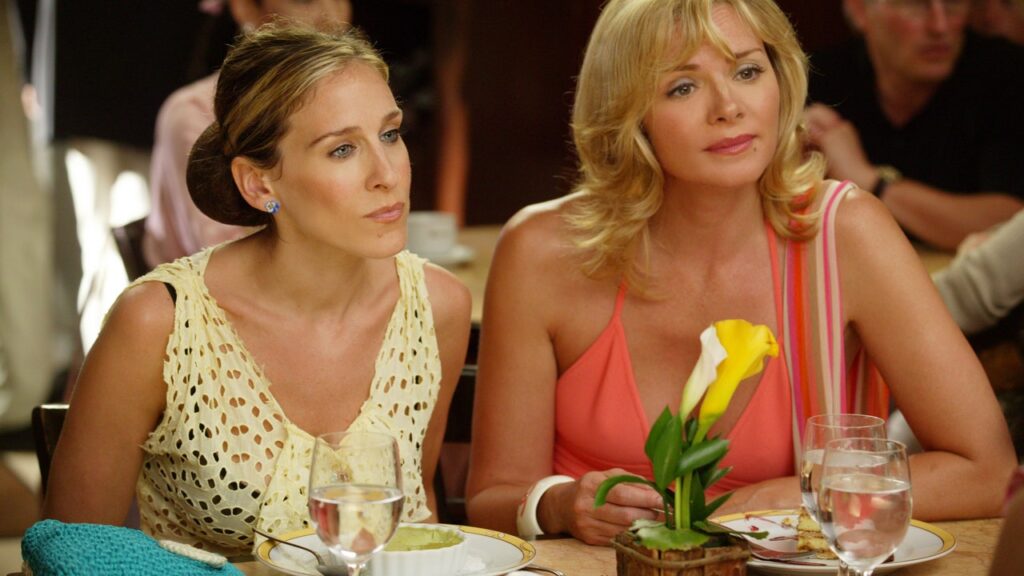The year is 2000, the setting, a New York restaurant renowned for its indulgent dessert options. Carrie has just ordered a flourless chocolate cake and a café au lait; Charlotte has ordered a fruit salad. “I hate my thighs,” Charlotte explains, her eyes pleading with Carrie for reassurance. “The problem is not your thighs, sweetie – the problem is your head,” quips Carrie, bending to try on her new Manolo Blahniks. “Now… about these shoes.”
As exchanges between two modern Western women go, it’s depressingly familiar. Who hasn’t been the woman ordering fruit for the sake of her thighs, or the woman whose own enjoyment of dinner has been marred by her friend’s talk of diets? Within the context of Sex and the City, however, it is something of an anomaly – because for almost the entire duration of this six-season, 84-episode series, calories are eaten, not discussed. While IRL Manhattan is awash with juice diets, in this fantasy version of New York, women eat in pursuit of pleasure, style, company and comfort – but rarely weight loss. The scenes in which weight is discussed stick out because there are so few of them – Samantha’s naked photo shoot, Miranda’s baby weight, and the “Attack of the Five Foot Ten Woman” spring to mind – and the matter is always swiftly dealt with. See Miranda’s rapier sharp “I’ve had a baby – what’s your excuse?” response to being body-shamed in Atlantic City, or Carrie’s breezy steering of the conversation back to her heels.
Was it deliberate, this exclusion of diet discourse? In a series that leaves no female conversational stone unturned, it’s a curious omission. After all, there’s no denying the centrality of food and drink in Sex and the City: almost every conversation they have is over coffee, brunch or cocktails. The women eat like they shop, without worry or consequence – and that was partly the point, says Cindy Chupack, one of the show’s writers. “Calories weren’t part of the food discussion in the same way money wasn’t really part of the life discussion. SATC was a celebration of those things women often neglect to celebrate, because they’re too busy worrying about their shape, their savings or seeing singledom as a stage to get through before getting married.”
Inevitably, this being the ’90s, this resulted in a degree of cognitive dissonance between what the gang ate, and what they looked like. Nevertheless, when I first came to the show as a teenager grappling with eating disorders, I found their unfettered enjoyment of food liberating. “Women like them in New York at that time would always be going to the gym and talking about diets. When it aired, Atkins was really popular – yet here you have a TV show about women where no one is talking about carbohydrates. I love that,” says journalist and author Hadley Freeman, who grew up in New York in the ’80s and ’90s.
In a column for The Guardian earlier this year, Freeman made a compelling (and highly entertaining) case for the SATC reboot to gloss over the pandemic, just like it did 9/11, and remain true to what she called its “fantastical framework”. “The idea that Carrie eats junk food all the time and doesn’t work out is as unrealistic as the idea that a newspaper columnist could afford to live on the Upper East Side and wear Dior Couture,” she tells me months later. “But a lot of women’s fantasies do include food, as much as they do sex or fashion. That’s what SATC is: a very feminine fantasy.”
It wasn’t the first time she’s referenced SATC in her column – and it won’t be the last, she laughs. However fantastical its premise, the show was a formative part of her early adulthood. “It was an idealised view,” Freeman acknowledges, “but there was always an emotional truth.” In Miranda’s devouring of an enormous cookie emblazoned with the words “I love you”, she sees a woman “who would rather eat a cookie than say ‘I love you’ to a man she doesn’t love. I had eating disorders which dragged on for a long time, and that scene really struck me.” Then there was the young woman Big dated, who doesn’t eat and does cocaine in the toilet. For all SATC’s high-octane glamour, this behaviour “wasn’t presented as fun. It was presented as boring and tragic.” There is no food to speak of in Candace Bushnell’s book, she points out – “so there must have been a decision by the scriptwriters that they wanted the women to enjoy everything in the city, including its food”.

